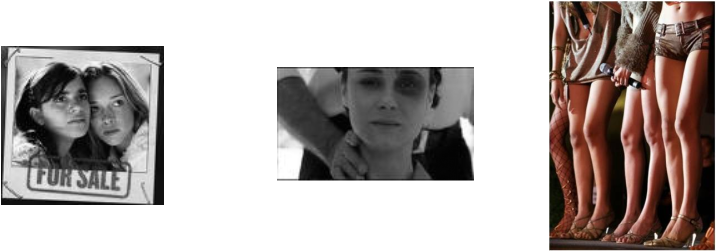Trafficking in Women:
Each year an estimated 14,500 to 17,500 women are trafficked into this country. Women have been trafficked to the U.S. primarily for the sex industry (prostitution, stripping, peep and touch shows, and massage parlors that offer a variety of sexual services), sweatshop labor, domestic servitude, and agricultural work.
With low risk and high profit potential, human trafficking may well become the new crime of choice. Police records show that young women can be sold to owners in North America for as much as US $16,000 each. In addition, when rescued, the young women tell of being forced to work off “debts” to traffickers of as much as US $40,000 by sexually servicing dozens of men per day.
Human trafficking is a relatively low risk business, but if successful, has high payoffs. Some experts claim that it generates about $7 billion.
Traffickers typically lure women with false promises of jobs as waitresses, nannies, models, factory workers, or situations with severely curtailed freedoms. Women are prevented from leaving by security guards, violence, threats, debt bondage, and/or retention of documents. The traffickers maintain control through isolation: in many cases, the women must live and work at the location. The women may also be denied outside medical assistance when needed, such as injuries due to sexual activities, abuse injuries, and sexually transmitted dieseases. Once recruited, the women usually find themselves being threatened with physical abuse against themselves and/or their families in order to force cooperation. Traffickers also play upon the women’s fears of arrest and deportation. In additional cases, trafficking victims suffer extreme physical and mental abuse, including rape, imprisonment, forced abortions, and physical brutality.
Each year an estimated 14,500 to 17,500 women are trafficked into this country. Women have been trafficked to the U.S. primarily for the sex industry (prostitution, stripping, peep and touch shows, and massage parlors that offer a variety of sexual services), sweatshop labor, domestic servitude, and agricultural work.
With low risk and high profit potential, human trafficking may well become the new crime of choice. Police records show that young women can be sold to owners in North America for as much as US $16,000 each. In addition, when rescued, the young women tell of being forced to work off “debts” to traffickers of as much as US $40,000 by sexually servicing dozens of men per day.
Human trafficking is a relatively low risk business, but if successful, has high payoffs. Some experts claim that it generates about $7 billion.
Traffickers typically lure women with false promises of jobs as waitresses, nannies, models, factory workers, or situations with severely curtailed freedoms. Women are prevented from leaving by security guards, violence, threats, debt bondage, and/or retention of documents. The traffickers maintain control through isolation: in many cases, the women must live and work at the location. The women may also be denied outside medical assistance when needed, such as injuries due to sexual activities, abuse injuries, and sexually transmitted dieseases. Once recruited, the women usually find themselves being threatened with physical abuse against themselves and/or their families in order to force cooperation. Traffickers also play upon the women’s fears of arrest and deportation. In additional cases, trafficking victims suffer extreme physical and mental abuse, including rape, imprisonment, forced abortions, and physical brutality.

